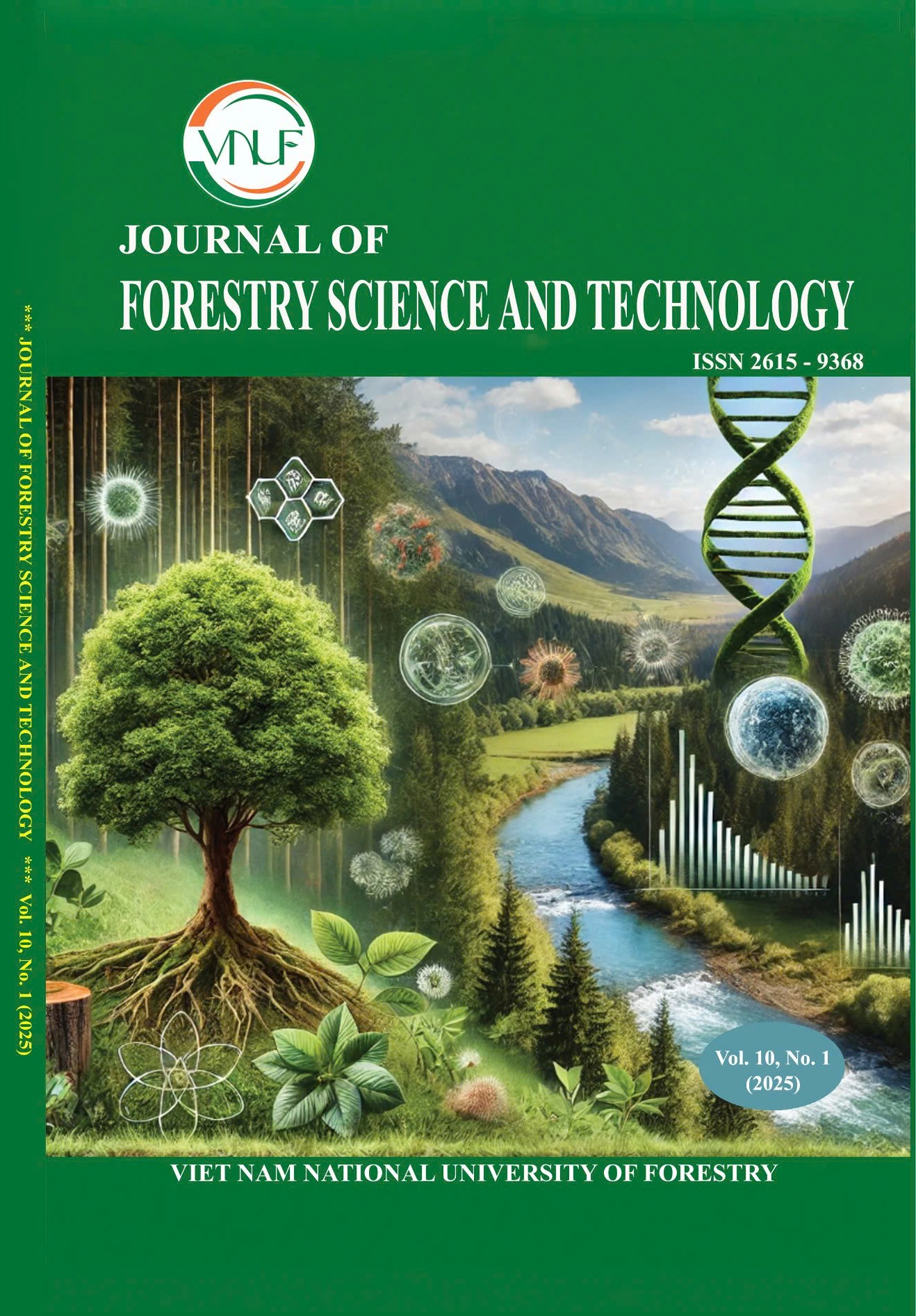Population dynamics and conservation assessment of two recently described Synapsis beetles in tropical karst ecosystems of Northern Vietnam
DOI:
https://doi.org/10.55250/Jo.vnuf.10.1.2025.052-060Keywords:
Dung beetles, IUCN Red List, karst ecosystems, Synapsis beetlesAbstract
The genus Synapsis Bates, 1868, comprises 24 species of large-bodied dung beetles, many of which are rare and highly specialised to the karst ecosystems of Southeast Asia. In Vietnam, seven Synapsis species have been documented, including the two recently described: Synapsis puluongensis Bui & Bonkowski, 2018, and Synapsis horaki Zídek & Pokorný, 2010. This study evaluated the population status, habitat preferences, and conservation needs of these two species across five karst ecosystems in Northern Vietnam from June 2023 to March 2024. Using baited pitfall traps and flight interception traps, we confirmed their rarity, highly specific habitat requirements, and dependence on undisturbed environments. Although S. puluongensis demonstrates a restricted range, small population size, and fewer than five known locations, the current study highlights insufficient data, particularly from other adjacent and similar ecosystems, to conclusively determine its status. As a result, it may be more appropriately assessed as Data Deficient (DD). Similarly, S. horaki was newly recorded in Phia Oac–Phia Den National Park, but its population remains poorly understood due to insufficient data and incomplete surveys. Habitat degradation caused by deforestation, limestone quarrying, and agricultural expansion poses significant threats to both species. Conservation efforts should prioritise protecting primary karst forests, expanding protected areas, restoring degraded habitats, and promoting sustainable land use practices. Further research into the ecological roles and distribution of Synapsis species is essential for their long-term conservation and the preservation of biodiversity in tropical karst ecosystems.
References
. Bui V. B. & Bonkowski M. (2018). Synapsis puluongensis sp. nov. and redescription of S. horaki (Coleoptera: Scarabaeidae), with a key to Vietnamese species. Acta Entomologica Musei Nationalis Pragae. 58(2): 407-418. https://www.aemnp.eu/data/article-1756/1737-58_2_407.pdf
. Nichols E., Spector S., Louzada J., Larsen T., Amezquita S., Favila M. E. & Network T. S. R. (2008). Ecological functions and ecosystem services provided by Scarabaeinae dung beetles. Biological conservation. 141(6): 1461-1474. DOI: 10.1016/j.biocon.2008.04.011
. Davis A. L., Van Aarde R. J., Scholtz C. H. & Delport J. H. (2002). Increasing representation of localized dung beetles across a chronosequence of regenerating vegetation and natural dune forest in South Africa. Global Ecology and Biogeography. 11(3): 191-209. https://onlinelibrary.wiley.com/doi/10.1046/j.1466-822X.2002.00283.x
. Clements R., Sodhi N. S., Schilthuizen M. & Ng P. K. (2006). Limestone karsts of Southeast Asia: imperiled arks of biodiversity. Bioscience. 56(9): 733-742.
DOI: 10.1641/0006-3568(2006)56[733:LKOSAI]2.0.CO;2
. Liew T. S., Price L. & Clements G. R. (2016). Using Google Earth to improve the management of threatened limestone karst ecosystems in Peninsular Malaysia. Tropical Conservation Science. 9(2): 903-920. https://journals.sagepub.com/doi/pdf/10.1177/194008291600900219
. Zidek J. & Pokorny S. (2010). Review of Synapsis Bates (Scarabaeidae: Scarabaeinae: Coprini), with description of a new species. Insecta Mundi. 0142: 1-21. https://digitalcommons.unl.edu/insectamundi/662
. Davis A. L. & Scholtz C. H. (2001). Historical vs. ecological factors influencing global patterns of scarabaeine dung beetle diversity. Diversity and Distributions. 7(4): 161-174.
DOI: 10.1111/j.1472-4642.2001.00102.x
. Bui V. B., Ziegler T. & Bonkowski M. (2020). Morphological traits reflect dung beetle response to land use changes in tropical karst ecosystems of Vietnam. Ecological Indicators. 108(2020): 105697.
DOI: 10.1016/j.ecolind.2019.105697
. Breiner F. T. & Bergamini A. (2018). Improving the estimation of area of occupancy for IUCN Red List assessments by using a circular buffer approach. Biodiversity and Conservation. 27: 2443-2448.
DOI: 10.1007/s10531-018-1555-5
. Blair M. E., Nguyen T. A., Le M. D., Liu Z., Meng T., Horning N., Sterling, Eleanor J., Thach H. M., Xu M. & Galante P. J. (2022). Karst as an abiotic driver of François’ langur distribution, with predictions for biological communities on karst under climate change. Frontiers of Biogeography. 14(1).
DOI: 10.21425/F5FBG51838
. Tuyet D. (2001). Characteristics of karst ecosystems of Vietnam and their vulnerability to human impact. Acta Geologica Sinica‐English Edition. 75(3): 325-329. DOI: 10.1111/j.1755-6724.2001.tb00539.x
. Luo Z., Tang S., Jiang Z., Chen J., Fang, H. & Li C. (2016). Conservation of terrestrial vertebrates in a global hotspot of karst area in southwestern China. Scientific Reports. 6(1): 25717.
DOI: 10.1038/srep25717









